After leaving the riverboat, Aria, in Budapest, Hungary, a small group of us traveled by coach to Prague, Czech Republic for a 4-night stay and then on to Vienna, Austria, for 3 nights. At that point we boarded the riverboat, Adagio, and cruised from Vienna to Amsterdam to finish the Grand European trip.
We are 22 in our group traveling with our Program Director, Irina, who will stay with us through our visit to Prague.
Along the way we pass many fields filled with sunflowers and wind generators. Irina tells us that the road we are on is the same road that the refugees recently took when leaving Budapest and heading to Vienna.
We stop for lunch and a city tour in Bratislava, the capital of Slovenia and the country's largest city. Bratislava is in southwestern Slovakia, occupying both banks of the Danube River and the left bank of the Morava River. Bordering Austria and Hungary, it is the only national capital that borders two independent countries.
This bridge is nicknamed the UFO bridge. It has a restaurant on the top.
High on a hill overlooking the capital city is the reconstructed Bratislava Castle, the original of which dates back to 907 AD. Today it houses a national museum.
Irina guided us through a walking tour in the old part of the city. St. Martin's Cathedral was built in 1452.
There is a crown on top of the steeple instead of a cross because the cathedral became the coronation church of the sovereigns of the Kingdom of Hungary in 1563. In total, the coronations of 11 kings and queens plus 8 of their consorts occurred here between 1563 and 1830, including that of Maria Theresa of Austria.
The main Slovak Holocaust Memorial is located in the center of the Old Town of Bratislava, on the site of the former Neolog Synagogue, which was demolished in 1967 by the Soviets.
The memorial was erected in 1996 by the Slovak Republic to commemorate the memory of 105,000 Holocaust victims from Slovakia. The location was not selected accidentally. The Holocaust memorial was composed as a place of public remembrance of the holocaust and the memory of the destroyed synagogue.
The marble wall was built where the synagogue once stood with an etching of the former synagogue on it.
We walked into the Old Town and passed the University of Comenius, a school of medicine.
Down the street we could see the Main Gate of the Old Town, which is the white tower at the end of the street.
As Bratislava looked to shed the greyness of the Communist era, many buildings were repainted, and in an attempt to enliven the city center, a few funny and quirky statues were installed.
The store fronts also provided a humorous touch...
The Slovak National Theater is the second oldest Slovak professional theater. It has 3 ensembles (drama, opera, and ballet).
Our restaurant for lunch in Bratislava...
As we left Bratislava, we saw one more monument. This statue is in remembrance of the victims of the communists. They show no emotion.
Having traveled through Slovakia, we were now in the Czech Republic and will stay 4 nights in Praque (Praha) before heading to Vienna (Wien), Austria.
Prague's regal beauty spreads on both sides of the winding Vltava River, connected by 16 picturesque bridges. Like Rome and San Francisco, the city is built over a series of hills and its architecture spans many centuries.

Prague was the only Central European capital to escape the bombs of the last century's wars; it is one of Europe's best-preserved cities.
Our very nice hotel, the Don Giovanni, located just an 8-minute subway ride to the City Center.
The next morning we were off on a tour of the Castle quarter and Old Town with Irina and local guide, Trudy. Our first stop is at Prague Castle, where for more than a thousand years Czech leaders have ruled.
 |
| Photo from the internet as I could never get a clear shot. |
...and the entertaining band in Castle Square.
Inside the Castle Gate we can see the tip of a 1,500 foot-long series of courtyards, churches and palaces.
In the corner of the square is the recently restored Chapel of the Holy Cross.
Inside are precious reliquaries and liturgical objects dating as far back as the reign of Charles IV, the Holy Roman Emperor who ruled his vast empire from Prague in the 14th century.
St. Vitus Cathedral contains the tombs and relics of the most important local saints and kings, including the first three Habsburg kings.
Started in 1344, construction was stalled by wars and plagues.
But, fueled by the 19th-century rise of Czech nationalism, Prague's top church was finished in 1929 for the 1,000th anniversary of the death of St. Wencelas....more on him later.
We were able to step inside for a few minutes.
The highlight was the 1931 Art Nouveau window designed by Czech Artist Alfons Mucha and executed by a stained-glass craftsman.
Back outside the cathedral there is an obelisk erected in 1928--a single piece of granite celebrating the 10th anniversary of the establishment of Czechoslovakia and commemorating the soldiers who fought for its independence.
Up in the green tower of the cathedral is the Czech Republic's biggest bell, nicknamed "Zikmund".
In June, 2002 it cracked, and 2 months later the worst flood in recorded history hit the city--the locals saw this as a sign. The Czechs are very superstitious and look at events and try to figure what fate has in store for them next.
The back Neo-Gothic side of the St. Vitus Cathedral.
Leaving Castle Hill, we then headed to Old Town, passing through just a small part of the Jewish Quarter on our way to the Old Town Square.
We only had time to have an orientation spin-tour around the square before it was time to head over to the Old Town Hall and its famous Astronomical Clock.
And we were not alone! There was a huge crowd there waiting to watch Christ and the 12 Apostles appear at two little windows above the clock face, followed by the skeleton of Death tolling the bell.
We then met up with Irina and she took us back to our hotel using the subway system.
In the evening we attended the Czech Countryside tour that took us out of town about 10-15 miles to a restaurant with a folklore show.
..and Jack bought an extra bottle, and we all shared that along with plenty of wine.
And so was the folklore show.
Terry took a spin around the dance floor with our Program Director, Irina.
We start the next day with Irina taking us to the Little Quarter of Prague. We traveled by subway and then walked through the beautiful Wallenstein Palace Gardens.
The gardens had beautiful hydrangeas, peacocks sitting in the trees, and a grotto wall where we tried to pick out images of animals, like a lion, cat, and snake.
Our next stop was the Church of Our Lady Victorious. It is the home of the Infant Jesus of Prague.
We stepped inside to see the statue...
When the Duchess Maria Manrique of Spain came to Bohemia to marry a nobelman in 1556. she received the statue from her mother as a wedding gift. When her daughter Polyzena of Lobkowicz was widowed, she gave the pprecious statue to the Carmelite nuns. He is the symbol of protection and numerous miracles are attributed to the statue.We then made our way through the streets of the Little Quarter to the entrance of the Charles Bridge.
It is a pedestrian-only bridge spanning the river for 500 yards over to the Old Town of Prague.
And we cross it...
Built in 1357, the Charles Bridge is lined with 32 statues of Jesus and various saints.
At the end of the bridge in a little square is the statue of the bridge's namesake, Charles IV, the Holy Roman Emperor who ruled his vast empire from Prague in the 14th century.
The statue was erected in 1848 to celebrate the 500th anniversary of Prague's university. Charles is holding a contract establishing the university, the first in Northern Europe.
The bridge tower on the Old Town side is considered one of the finest Gothic gates anywhere.
The sculptures on the tower show the 14th century hierarchy of kings, bishops and angels.
Irina let us loose for the afternoon to explore Prague on our own. We teamed up with Catherine, Jack, and Don and did a walk through Old Town. With the help of Rick Steves' guidebook, we learned more about the memorials and churches.
The monument in the center of the Old Town Square was erected in 1915 and symbolizes the long struggle for Czech freedom.
It is a memorial to Jan Hus, a Prague priest who defied the Catholic church and the Habsburg oppressors. On the monument Jan Hus stands tall between two groups of people: the victorious Hussite patriots, and Protestants defeated by the Habsburgs in 1620. One patriot holds a chalice (cup) representing what they were fighting for.
The Tyn Church was the headquarters and leading church of the Hussite followers of Jan Hus.
Between the two towers is the golden medallion of the Virgin Mary. Beneath is an empty niche where the Golden Chalice once stood, which symbolized the Hussite cause--for every Christian to participate in communion.
After the Habsburg 1620 victory, the church was converted to Catholic and the chalice was melted down and made into that golden image of Mary. The niche remains empty.
Embedded in the pavement next to the Town Hall there are white inlaid crosses marking the spot where 27 Protestant nobles, merchants, and intellectuals were beheaded in 1621 after rebelling against the Catholic Habsburgs.
The execution ended Czech independence for 300 years and is still one of the grimmest chapters in the country's history.
The Old Town Hall was built in the 14th century. On the tower is the famous Astronomical Clock.
This all takes place in a matter of seconds....a crowd of people wait to capture a photo for about 30 minutes!
We continued our walk by seeing the "House of the Black Madonna", a brown modern angular structure of the Cubist architecture popular in Prague in the early 20th century.
The Powder Tower, the main gate of Old Town, is 500 years old. It housed the city's gunpowder and has the best 15th century sculpture on the Gothic tower.
The Municipal House is the "pearl of Czech Art Nouveau". With the elaborate wrought iron balcony, goddess Praha presides over a land of peace and high culture. It stoked cultural pride and national sentiment. We did not go inside unfortunately....I understand it is beautiful.
In the square outside the Hotel Europa, on a November night in 1989, thousands of Czechs and Slovaks gathered and future Czech president Vaclav Havel proclaimed the imminent freedom of the Republic of Czechoslovakia. He pulled out a ring of keys and jingled it saying "the communists have packed up and left and now we are free to unlock our chains".
In front of the National Museum there is a huge statue of Good King Wenceslas on a horse.
King Wenceslas I was the "good king" of Christmas-carol fame. He was a wise and benevolent 10th-century duke who united the Czech people back when this land was known as Bohemia. He was credited by his people for Christianizing his nation and lifting the culture.
Wenceslas Square, which is actually a long boulevard, has served as a kind of national stage for important events in the history of the Czech people.
Here the people would gather to celebrate the end of World War I in 1918, the end of the Nazi occupation after World War II and held demonstrations in 1968 when Soviet tanks rumbled into Prague.
After the Russian crackdown of 1968, a group of patriots wanted to stand up to the powerful Soviet occupation. One was a young philosophy student named Jan Palach. He decided that the best way to stoke the flame of independence was to set himself on fire.
On January 16, 1969, Palach stood on the steps of the National Museum and set his body on fire for the cause of Czech independence. Twenty years later Czechs gathered for protests and it led to the overthrow of the Czech communist government in 1989 and to freedom.
That evening we went to the Mozart Cafe for a delicious meal and jazz music with our friends Catherine, Jack, and Don.
It was dark by the time we headed back to the hotel. Old Town was beautiful all lit up.
We had one more day in Prague where we went outside the city to visit a concentration camp. To continue reading, scroll back toward the top of this page and click in the right column the entry entitled: Terezin Concentration Camp.
















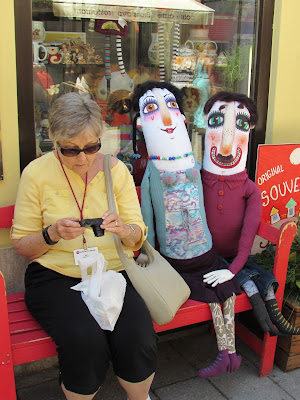


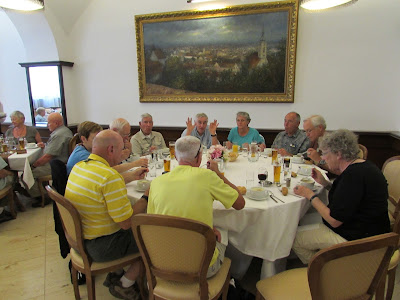






























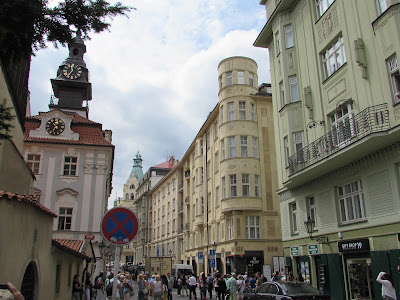

























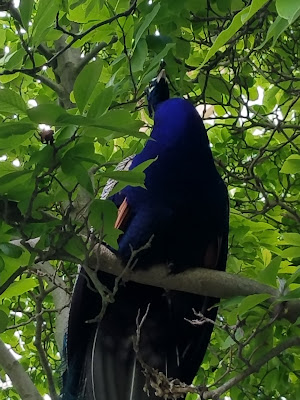
































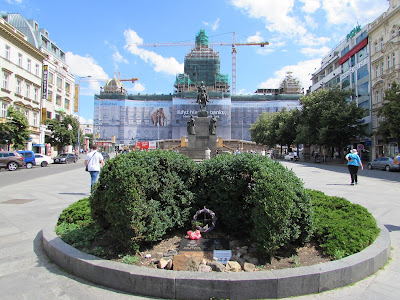






No comments:
Post a Comment